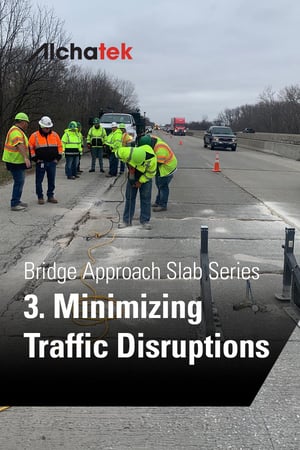
 One of the most pressing challenges in infrastructure maintenance is managing slab repairs on busy roadways, including bridge approach slabs, streets, and highways. These repairs often lead to unavoidable traffic disruptions, posing operational challenges that can significantly impact the daily commute and local economy. As a result, there's an increasing need for solutions that are not only effective in restoring structural integrity but also quick, thus minimizing the time lanes are closed.
One of the most pressing challenges in infrastructure maintenance is managing slab repairs on busy roadways, including bridge approach slabs, streets, and highways. These repairs often lead to unavoidable traffic disruptions, posing operational challenges that can significantly impact the daily commute and local economy. As a result, there's an increasing need for solutions that are not only effective in restoring structural integrity but also quick, thus minimizing the time lanes are closed.
Traditional vs. Modern Methods
Time and Labor in Different Repair Methods
Traditional methods like mudjacking and full slab replacement usually involve an extended timeline and a considerable labor force. Mudjacking, for example, may require several days for preparation, execution, and curing. Full slab replacement can take even longer due to the time required for demolition, re-pouring concrete, and allowing it sufficient time to cure.
The Advantage of Polyurethane Concrete Leveling
In contrast, modern techniques using polyurethane foam injection for concrete leveling stand out for their speed and efficiency. This process involves drilling small holes into the slab, injecting polyurethane foam, and allowing it to stabilize the soil beneath while lifting the slab into place. The foam sets quickly, usually within a matter of minutes, and reaches full strength shortly thereafter. As a result, traffic can often resume the same day, or even within hours, thereby reducing both labor costs and time delays.
Planning for Lane Closures and Alternate Routes
Effective planning is crucial to minimize the impact on regular traffic flow. Authorities should decide in advance which lanes will be closed and when. The timing can be coordinated to occur during non-peak hours. Information about these closures should be well-publicized in advance, using electronic billboards, social media, and local news outlets. Creating well-signposted alternate routes can help divert traffic away from the repair site, reducing congestion.
Key Takeaways
The modern method of using polyurethane foam injection significantly speeds up the slab repair process, thereby minimizing traffic disruptions and operational challenges. Proper planning and coordination among various departments can further streamline the process, ensuring that repairs are completed in the most efficient and least disruptive manner possible.



